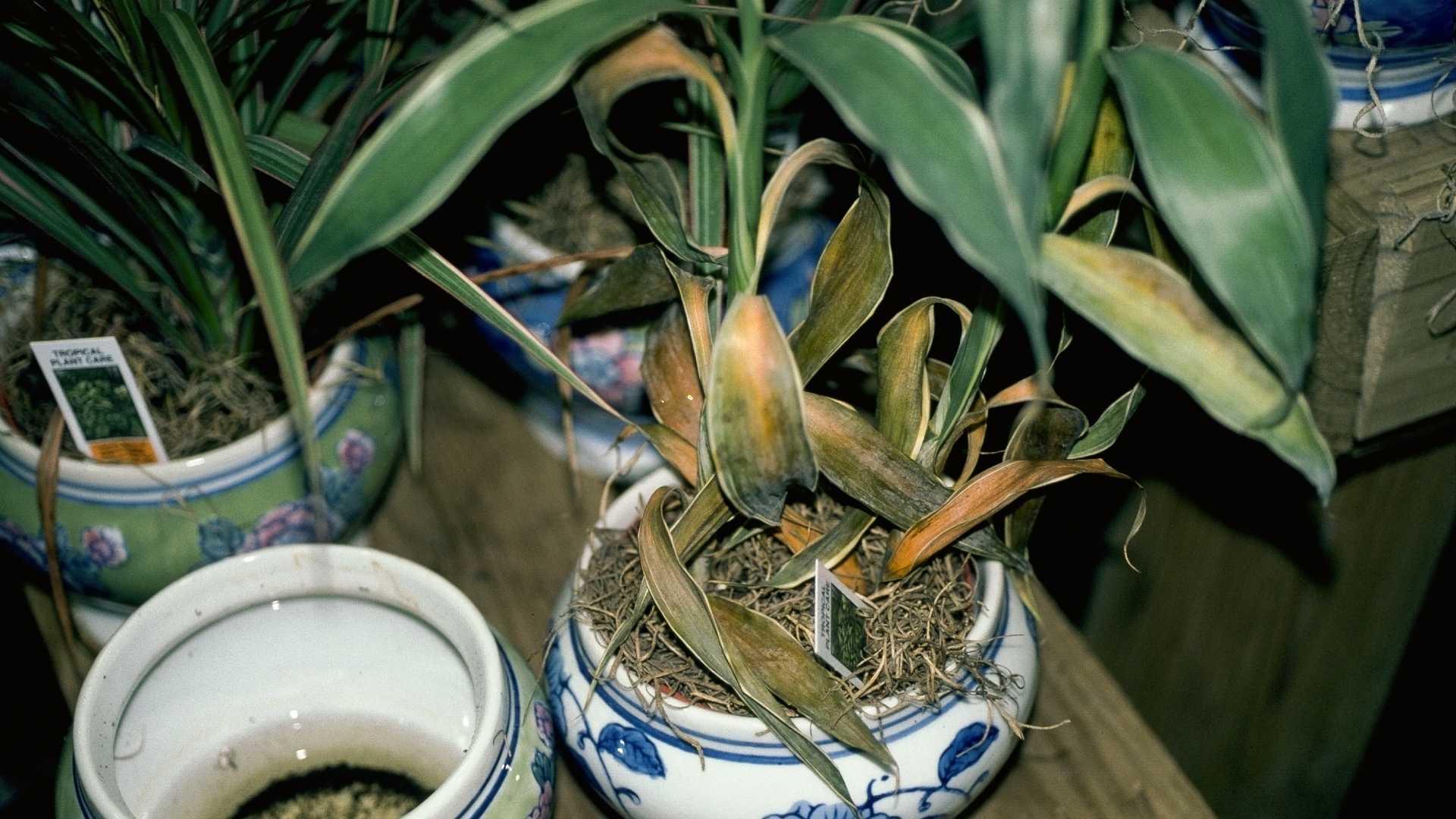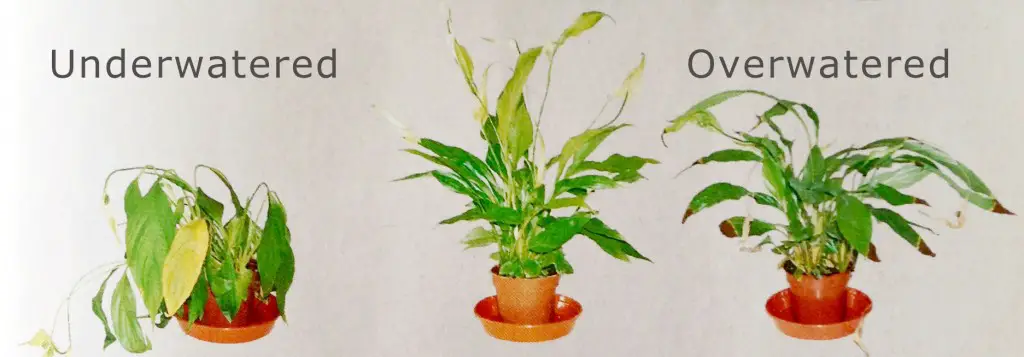Yellowing leaves and root rot are common signs of overwatered house plants. Soil that remains wet for extended periods is also a clue.
Overwatering house plants is a frequent issue that can lead to various problems. Recognizing the signs early is crucial for plant health. Yellowing leaves, root rot, and consistently wet soil are clear indicators. These symptoms can stress the plant, making it more susceptible to diseases.
Over time, the plant may struggle to absorb nutrients, leading to stunted growth. Proper watering practices are essential to maintain the balance. Ensuring that the soil dries out between waterings can prevent these issues. Understanding the right amount of water each plant needs is key to keeping them healthy and thriving.
Signs Of Overwatering
Overwatering houseplants is a common mistake. Knowing the signs can help. Below are key indicators your plant might be getting too much water.
Yellowing Leaves
One of the first signs is yellowing leaves. Healthy leaves are green. If they turn yellow, check the soil. Wet soil can cause the roots to rot. Rotting roots can’t absorb nutrients. This leads to the leaves changing color. Yellow leaves often start at the bottom of the plant. If you see this, you might be overwatering.
Wilting Appearance
A wilting appearance can also indicate overwatering. It might seem strange, but too much water can make the plant wilt. Wilting plants look droopy and lifeless. Their leaves might feel soft or mushy. The soil may be wet, but the plant looks weak. This happens because roots can’t breathe. They need air to stay healthy. Overwatering fills the air spaces in soil with water.
| Sign | Description |
|---|---|
| Yellowing Leaves | Leaves turn yellow, especially at the bottom. |
| Wilting Appearance | Plant looks droopy and weak despite wet soil. |

Credit: www.gardengatemagazine.com
Soil Indicators
House plants often show signs of overwatering through their soil. Knowing these soil indicators can save your plants. These signs can alert you early before the plant suffers too much.
Soggy Soil
Soggy soil is a clear sign of overwatering. The soil should be moist but not drenched. You can check this by touching the soil. If it feels very wet, it’s overwatered.
Another way to tell is by lifting the pot. An overly heavy pot means too much water. A light pot suggests the right amount of water. Ensure proper drainage to prevent soggy soil.
Mold Growth
Mold growth on the soil surface is another indicator. Mold is usually white or gray and appears fuzzy. It thrives in damp conditions, which means too much water.
Check the soil regularly for mold. If you see mold, reduce watering and improve air circulation. Mold can harm your plant’s health if left unchecked.
Root Health
Healthy roots are essential for thriving house plants. Root health problems signal overwatering. Learn how to check root health to save your plant.
Root Rot
Overwatered plants often suffer from root rot. Root rot happens when roots stay too wet. The roots cannot get enough oxygen and start to decay. You may notice a foul smell from the soil. This is a clear sign of rot. The roots will feel mushy and soft. Healthy roots should be firm.
Discolored Roots
Healthy roots are usually white or light tan. Overwatered plants have discolored roots. Check for brown, black, or gray roots. These colors suggest the roots are rotting. Discolored roots are another sign of poor root health.
| Healthy Roots | Overwatered Roots |
|---|---|
| White or light tan | Brown, black, or gray |
| Firm to the touch | Mushy and soft |
| No smell | Foul odor |
- Check roots often to spot problems early.
- Use well-draining soil to prevent overwatering.
- Allow soil to dry between waterings.
- Remove the plant from the pot.
- Rinse the roots gently.
- Trim off any rotten or discolored roots.
- Repot the plant in fresh soil.
Leaf Symptoms
House plants can be a delightful addition to any home. But overwatering them can lead to problems. One of the first signs of overwatering is changes in the leaves. These changes can help you identify if your plant needs less water.
Dropping Leaves
Dropping leaves are a common sign of overwatering. If your plant’s leaves fall off easily, it may be getting too much water. The leaves might turn yellow before falling off. Watch for this early sign to save your plant.
Edema
Edema is another symptom of overwatering. This happens when the plant takes in more water than it can use. The excess water causes cells to burst. You might see small, water-filled blisters on the leaves. These blisters can turn into brown, corky patches. This is a clear sign that your plant is overwatered.
Monitoring these leaf symptoms can help you keep your house plants healthy. Adjust your watering routine if you notice these signs. Your plants will thank you!
Watering Frequency
Understanding watering frequency is crucial for healthy house plants. Too much water can harm your plants. Learn the right schedule to keep them thriving.
Daily Watering Risks
Daily watering can drown your plants. Plants need air in the soil. Overwatering fills soil pores, blocking air. Roots suffocate without air. This leads to root rot and weak plants.
Signs of overwatered plants include:
- Yellowing leaves
- Mushy stems
- Wilting
These signs mean your plant is stressed. Reduce watering immediately. Let the soil dry out between waterings.
Ideal Watering Schedule
Follow an ideal watering schedule for healthy plants. Water plants only when the top inch of soil is dry. This ensures roots get both water and air.
Use this table for a simple guide:
| Plant Type | Watering Frequency |
|---|---|
| Succulents | Every 2-3 weeks |
| Ferns | Once a week |
| Flowering Plants | Twice a week |
Adjust the frequency based on plant needs and environment. Always check the soil before watering. This prevents overwatering and keeps plants healthy.
Pot And Drainage
Proper pot and drainage are essential for healthy house plants. Overwatering often results from poor pot and drainage choices. Understanding how to select the right pot and ensuring adequate drainage will help keep your plants thriving.
Proper Pot Selection
Choosing the right pot can prevent overwatering issues. Pots come in various sizes and materials. Each has unique benefits and drawbacks.
- Material: Clay pots are breathable but dry out quickly. Plastic pots retain moisture longer.
- Size: Ensure the pot size matches the plant’s root system. Too big, and the soil retains too much water. Too small, and roots become cramped.
Importance Of Drainage Holes
Drainage holes are crucial for plant health. They allow excess water to escape, preventing root rot.
| Pot Type | Drainage |
|---|---|
| Clay Pot | Has natural drainage but dries quickly. |
| Plastic Pot | May need added holes for better drainage. |
| Metal Pot | Typically lacks drainage holes. |
Pro Tip: If your pot lacks drainage holes, create some using a drill.
Use a pot tray to catch excess water but ensure you empty it regularly. This prevents water from re-entering the pot and causing overwatering.
Recovery Techniques
Overwatering is a common problem for house plants. Identifying and addressing it quickly is crucial for plant health. Here are some effective recovery techniques to help your house plants bounce back.
Drying Out The Soil
One of the first steps to revive an overwatered plant is to dry out the soil. Wet soil can suffocate plant roots, leading to root rot. Follow these steps to dry out the soil:
- Remove the plant from its pot and place it on a newspaper.
- Let the soil air dry for a few hours to a day.
- Check the soil moisture with your finger.
If the soil is still damp, you can try these additional methods:
- Place the plant in a warm, well-ventilated area.
- Use a fan to speed up the drying process.
- Ensure the plant is not in direct sunlight to avoid stress.
Repotting
Sometimes, drying out the soil is not enough. In such cases, repotting the plant might be necessary. Follow these steps to repot an overwatered plant:
- Gently remove the plant from its current pot.
- Shake off excess soil from the roots.
- Trim away any rotten or mushy roots with sterilized scissors.
- Choose a new pot with drainage holes to prevent future overwatering.
- Fill the new pot with fresh, well-draining soil mix.
- Place the plant in the new pot and fill around it with soil.
- Water the plant lightly to help it settle in the new soil.
By following these recovery techniques, your house plants have a better chance of surviving and thriving after being overwatered. Remember, prevention is key. Always check soil moisture before watering.

Credit: extension.umd.edu
Preventive Measures
Preventing overwatering is crucial for the health of your house plants. Implementing preventive measures will save your plants from the dreaded root rot. Here are some effective strategies to ensure your plants thrive.
Monitoring Moisture Levels
Regularly check the soil moisture to avoid overwatering. Use a moisture meter for accurate readings. Insert the meter into the soil and read the moisture level.
Alternatively, use the finger test. Stick your finger into the soil up to the first knuckle. If the soil feels moist, wait before watering again. If dry, it’s time to water.
Keep a watering schedule. Write down the dates you water each plant. This helps you keep track of watering frequency and avoid overwatering.
Using Proper Soil Mix
Choose the right soil mix for your plants. Well-draining soil prevents water from sitting around the roots.
Avoid heavy soils that retain too much water. Use a mix of peat, perlite, and sand for better drainage.
Consider adding organic matter. Compost or coconut coir improves soil structure and drainage.
Here is a simple recipe for a well-draining soil mix:
| Ingredient | Quantity |
|---|---|
| Peat Moss | 2 parts |
| Perlite | 1 part |
| Sand | 1 part |
Mix these ingredients thoroughly before using them for potting your plants.

Credit: www.familyhandyman.com
Frequently Asked Questions
How Do I Fix An Overwatered Plant?
First, remove the plant from its pot. Trim any rotten roots. Let the plant dry out. Repot using fresh, well-draining soil. Water sparingly until it recovers.
How Do You Tell If A Potted Plant Is Overwatered?
To tell if a potted plant is overwatered, check for yellowing leaves, soggy soil, and root rot. Leaves may feel soft or mushy. Mold or fungus on the soil surface also indicates overwatering.
How To Tell The Difference Between Overwatering And Underwatering?
Overwatered plants have yellowing, soft leaves and may develop root rot. Underwatered plants have dry, brown, and crispy leaves. Check soil moisture to confirm.
How Do I Know If My Indoor Plants Need Water?
Check soil moisture by sticking your finger 1 inch into the soil. If it’s dry, water your plant. Drooping leaves and dry, brown edges also indicate the need for water. Use a moisture meter for precise readings.
Conclusion
Recognizing signs of overwatering can save your house plants. Keep an eye on yellow leaves and root rot. Ensure proper drainage and adjust your watering schedule. Healthy plants thrive with balanced care. By understanding their needs, you can create an ideal environment for growth.
Happy gardening!

My mission is to help you bring the beauty of nature indoors with expert advice, detailed plant care guides, and creative design ideas.





Leave a Reply